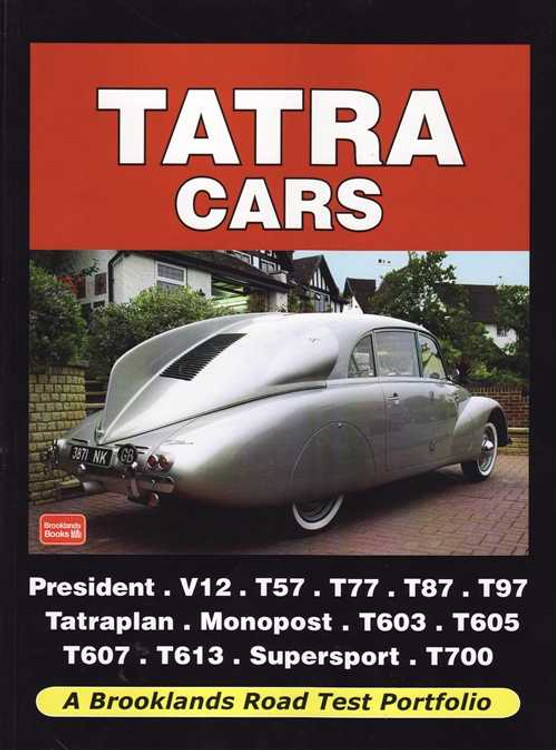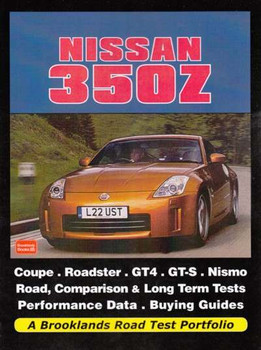Description
By: Brooklands Books .
Description
This portfolio of articles from around the world traces the 100 year history & provides a fascinating look at a truly unconventional marque. Included are road tests, new model reports, performance data & specs. Models covered include the President, V-12, T57, T77, T87, T97, Tatraplan & Sport, Monopost, T603, T2-603, T605 Sport, T607, T613, T613-2, Metalex Tatra V8 Supersport and the T700.
A total of 140 fully illustrated pages
Tatra Cars Introduction
In all probability the most famous model produced by Tatra is the streamlined 1934 Type 77, a futuristic-looking saloon car with a rear-mounted air-cooled V8 engine. Designed by Hans Ledwinka, this amazing aerodynamic machine also featured an early form of unitary body construction (in other words there was no separate chassis) and independent suspension all round. Not only was the extraordinary Tatra's styling and engineering well ahead of its time, the T-77 could also cruise comfortably at 80mph - a speed way beyond the maximum achievable by most average European family cars in the '30s. But the story of Tatra is about much more than the T-77, with sports cars and even single-seater racers appearing after the Second World War, by which time Ledwinka had left the company. Truck manufacturing also dates from the very early days of Tatra (commercial vehicles have always generated a major percentage of the company's revenue) and in 1999 car production was abandoned to concentrate on lorries and all-wheel-drive vehicles - which continues to this day - but that aspect of Tatra is outside the remit of this book.
The heritage of Tatra can actually be traced back as far as the 1850s when a wheelwright named Ignac Sustala set up a workshop to build horse-drawn carts with two colleagues in the small Moravian town of Nesselsdorf (now Koprivnice). All types of carriages and wagons were produced and Sustala gained an international reputation as a coachbuilder, but the death of his wealthy backer saw the business get into financial problems. However, in 1881, an order to make railway carriages saved the company from bankruptcy and from then on the factory expanded rapidly. It was the influence of Baron Theodor von Liebig, an Austrian textile tycoon and motoring pioneer, that led the company to enter the infant automobile industry. A Benz car was purchased (together with a spare two-cylinder engine) in 1897 and minutely examined by the technicians of the Nesselsdorfer Wagenbau-Fabriksgesellschaft who used the information they had gained from the procedure to construct a prototype. This car was completed towards the end of 1897 and given the name President.
Included in the group responsible for the President was a young engineering student named Hans Ledwinka who would later become one of the world's most innovative automotive designers, but works manager Leopold Svitak is usually given the credit as being the leading light on the project. A second prototype was followed by a batch of ten cars , that incorporated a number of revisions to the original design and during the years leading up to the First World War further developments ensued. The birth of Czechoslovakia as a nation in October 1918 saw the company name changed to Tatra (after the country's highest range of mountains) and Ledwinka return from Steyr to start work on a new car, the Typc 11. Competition wins made the Type 11 a popular car and its successor, the Type 12, remained in production until 1929. Other models came and went - including the monstrous 6-litre V-12 Type 80 - before war intervened again. When car making resumed it was as Tatraplan and in 1947 the T600 was introduced but progress stagnated under communist rule. Italian stylist Vignale was engaged to design the replacement T613 in 1968 and this remained as the basis of Tatra cars over the final three decades as production declined.
Tony Beadle
Contets
- The Tatra: A Radical Simplicity
- Seventy-Five Years of Tatra
- The Incredible Tatra!
- The 12-Cylinder Tatra
- A Czechoslovakian Light Car
- An Unconventional Light Car
- On the Tatra Trail - T57 Cabriolet
- 1939 Tatra 87
- Slippery Survivor Type 97
- "Liberated Tatra"
- Closed Car Contrasts
- The Tatraplan Sports Car
- Tatra: The Best Red Car
- A Commie Car!
- A Single-Seat V8 Tatra Test-Bed
- New Exhaust-Cooled Tatra
- Speed From Czechoslovakia
- Tatra - 603-2
- Opinion
- Tatras and Skodas...
- A Tatra From Czechoslovakia
- Tatra 77
- Driving the World's Only Rear-Engined V8 Saloon
- State Express - T2 T603 Rarity
- Look, Vladimir: No Vladiator
- Unorthodox Communist
- Party Time - 603
- Tatra for Now
- Impressive Oddity - T613
- Tatra - Factory Visit & 613
- Big Tatra - 613
- Reach For Your Czech Book...
- Official Transport - 613
- Tatra Breaks Free - 613
- Prague Uprising - Metalex Tatra V8 Supersport
- Tatra Tour
- Czech, Mate
- Czech Matey
- Tatra - 603
- Tatra T2-603
- Bouncing Czech - T700
- S-Classki - T700
- Czech Mate - T87





















